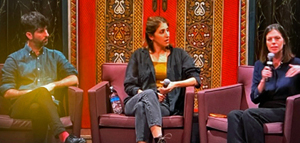mark! Lopez Fights for East Los Angeles, Wins Goldman Environmental Prize
Environmental justice advocates may be feeling discouraged as they watch the Trump administration dissemble regulations piece by piece.
However, each year, the Goldman Environmental Prize winners remind us that activism can start with one person.
The 2017 awardee from North America is mark! Lopez, a 32-year-old community organizer from East Los Angeles.
Lopez, who received a degree in Environmental Studies from UC Santa Cruz and a Master’s from Cal State Northridge, came to his calling early. Raised in a family where his parents and grandparents were advocates in defense of their neighborhood, he attended rallies and marches alongside them.
East Los Angeles is described by Lopez as a “hardworking, family-driven community.” It is also a frontline zone that is oversaturated with industrial sites, heavily trafficked freeways, and emissions emanating from port related cargo transports. School, homes, playgrounds and parks are in immediate proximity to these sources of air pollution.
To make matters worse, in 2000, Exide Technologies took possession of a battery recycling plant in Vernon. The smelter, eight decades old, was made operative — skipping needed repairs and improvements. They functioned with temporary permits and collected numerous violations.
The equivalent of forty truckloads of lead-acid car batteries per day was processed. Fumes included arsenic. The lead dust was pervasive; 7 million pounds were released into the air. Samples revealed lead to be at a “hazardous level.”
Children from the area were tested. Their blood had one hundred times above the health limit amount. Lead and children are a deadly combination. It is a neurotoxin that causes brain damage — as well as behavioral and learning issues.
When Lopez returned home after college, his grandmother informed him that the Exide facility was still running.
In response, Lopez initiated an outreach campaign to educate his neighbors about the lead contamination. He joined the East Yard Communities for Environmental Justice (EYCEJ), where he is now the Executive Director. He urged residents to take advantage of free lead testing.
Two hundred homes were analyzed. Only three didn’t show findings for lead. It became clear that a wider assessment was needed.
At the state’s capital, Sacramento, Lopez testified on government panels. He underscored the need for broader soil examination. He pointed out he disparity in reaction time between the Exide scenario in East Los Angeles and the gas leak in Porter Ranch — an affluent community.
In April 2016, Gov. Jerry Brown approved $176 million to expand lead testing of 10,000 homes impacted by the Exide pollution, and a cleanup of the 2,500 homes found to have the highest hazardous levels of lead.
Lopez was made co-chair of the advisory committee in charge of overseeing the efforts.
However, as Hilda Solis, Los Angeles County Supervisor pointed out, “The actual cost to do a full and proper cleanup would cost $300 million.” She added, “This is our Flint, Michigan.”
I reached out to Lopez to ask him about his work.
What are your thoughts on where the future of Environmental Justice stands in the Trump administration?
“Regardless of who the president is, it is important to remember that movement starts at the grassroots. We began by knocking on doors and informing our community about Exide, and encouraging people to take action and fight for all of our health. If we start by working with our neighbors, soon enough we’ll organize our block. If we can organize our block, we can organize the blocks around us, and our communities. If we can organize our communities, we can connect with other organized communities and elevate the struggle. That is true no matter who is in office. We do not need to lose hope because change begins on the ground and becomes a movement when people come together.”
What has been determined about the monies that will be awarded for cleanup?
“Since the lead contamination could very easily go beyond the 1.7-mile radius originally tested, we keep pushing for more testing until we can find the edge of contamination. For that we need additional funds. The Lead-Acid Battery Recycling Act of 2016 is expected to produce $30-32 million annually via a battery fee. A portion of that will go to cleanup Exide contamination, as well as “ghost smelters” (Closed sites with no responsible party across the state of California.) Estimates of total cleanup for Exide are in the hundreds of millions of dollars, so securing funding will continue to be a priority for us moving forward.”
What advice can you share with other parents concerned about their children and the outlook for environment?
“There is no safe level of lead for children, and I fear for my daughters’ safety as any parent would. This fight is for my children, but also the entire area. When confronted with issues, we have to be the ones to stand up and advocate for ourselves and our neighbors. I grew up with a sense of community. I was taught that I needed to do well in school, not to ‘make it out,’ but so that I could contribute to my community.
I’m raising my daughters with the same ethics and worldviews that have been passed down for generations in my family and community. Most importantly, the struggles we start today are struggles our babies don’t have to start tomorrow.”
For those who question the validity of individual and group action…Exide closed its Vernon plant in March of 2015, after a federal investigation into its operation.
This article originally appeared on the website Moms Clean Air Force.





